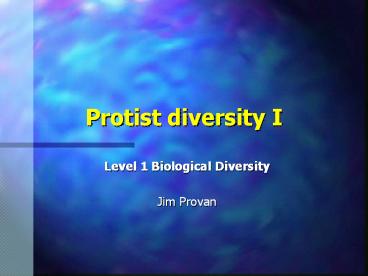Protist diversity I - PowerPoint PPT Presentation
1 / 14
Title:
Protist diversity I
Description:
Protist diversity I Level 1 Biological Diversity Jim Provan Diversity of protists In Whittaker s five-kingdom system, eukaryotes were divided into four of the five ... – PowerPoint PPT presentation
Number of Views:289
Avg rating:3.0/5.0
Title: Protist diversity I
1
Protist diversity I
- Level 1 Biological Diversity
- Jim Provan
2
Diversity of protists
- In Whittakers five-kingdom system, eukaryotes
were divided into four of the five kingdoms - Animalia
- Fungi
- Plantae
- Protista
- Kingdom Protista originally contained all
eukaryotes that did not fit into one of the other
three kingdoms - Mostly microscopic, single-celled organisms
- Extremely diverse
- Paraphyletic
3
Protist diversity
4
Paraphyly of protists
5
Protist diversity
- Nutrition
- Mostly aerobic and use mitochondria
- May be photoautotrophic, heterotrophic or
mixotrophic - Different modes scattered throughout different
lineages - Motility
- Life cycles
- Asexual, sexual and syngamous
- Can form cysts
- Habitat
- Mostly aquatic plankton and phytoplankton
- Symbionts
6
The chloroplast
- Carries out photosynthesis
- Contains own genome
- Believed to be of endosymbiotic origin
- Phylogenetically related to cyanobacteria
7
The mitochondrion
- Primary site of oxidative phosphorylation
- Contains own genome
- Gene sequences suggest closest relationship with
?-proteobacteria - Believed to be of endosymbiotic origin
8
Compartmentalisation of the eukaryotic cell
9
Serial endosymbiosis
- Explains evolution of mitochondria and plastids
- Theory proposes ancestral endosymbiosis (one cell
living inside another) - Mitochondria derived from a-proteobacteria
- Chloroplasts derived from cyanobacteria
- Either undigested prey or internal parasites
- Some eukaryotes lack chloroplasts but most have
mitochondria suggests that mitochondria evolved
first
10
Evidence for the theory of serial endosymbiosis
- Other endosmbiotic relationships are successful!
- Morphological similarity appropriate size
- Membranes contain similar enzymes
- Replicate by binary fission
- Single, circular genome
- Bacteria-like ribosomes and tRNAs
- DNA evidence (?)
11
Secondary endosymbiosis
- Several taxonomic groups have plastids
- Plants
- Chlorophytes s.s. (Chlamydomonas)
- Rhodophytes s.s. (Porphyra)
- Glaucocystophytes (Cyanophora)
- Chlorarachniophytes (Chlorarchnion)
- Euglenids (Euglena)
- Cryptomonads (Guillardia)
- Haptophytes (Emiliana)
- Heterokonts (Laminaria, Phytophthora)
- Dinoflagellates (Amphidinium)
- Apicomplaxans (Plasmodium)
- Ciliates (Paramecium)
12
Algal lineages
Primary (Double membrane) Secondary (Thre
e or more membranes)
Cryptophytes Heterokonts Haptophytes
Dinoflagellates Apicomplexans
Euglenoids Chlorarachniophytes
13
Eukaryotes and the big picture of evolution
14
Eukaryote phylogeny































